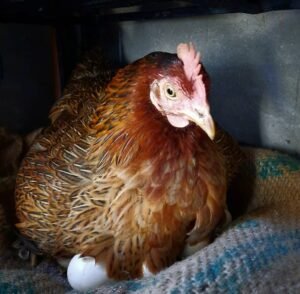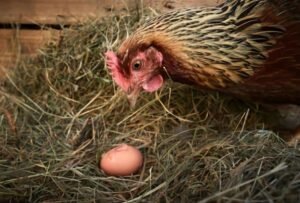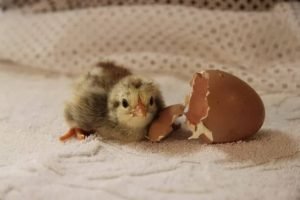How Do Chickens Mate? A Detailed Explanation

Have you ever wondered “How do chickens mate?”
All those climbing and all, how does it form eggs?
Is mating for chickens pleasurable?
So many questions you may be wondering but here’s a quick fact you should know.
Mating for chickens is not like people.
In fact, if people mated like chickens, it would be odd and unthinkable.
There is absolutely no romance involved.
Now you can tell why the hens will quickly shrug that aggressive touch and mount off her back immediately the cockerel jumps off.
“Phew” that’s not good.
Because being around the farm will make you see the chickens mating, it’s expedient you understand how this goes.
In fact, chickens mate so much that it can cause a lot of problems for your hens if you’re not careful most especially if you have multiple roosters.
Have you heard of the Mating Dance?
Find out below !!!
What you should know about chicken mating
From a hen’s perspective, mating is nothing to look forward to in the romance department.
There are no candlelight dinners, chocolates or flowers.
Not even a simple courteous “woo”.
But for a rooster, mating represents a physical challenge.
Beyond reproduction, sexual satisfaction and egg production, chicken mating is a social thing for the roosters.
Roosters use this avenue as an avenue to establish a hierarchy in the poultry house.
One has to lead the flock, and mating is a way rooster compete to get the rooster crown and become the “King of the flock”
Besides that, the top rooster gets to pass his genetic value on to the hens, who in turn hatch his offspring.
Sadly, the female chickens are usually vulnerable and compliant.
Once they mate too much, they will be affected psychologically and health-wise.

What should I look out for when chickens mate?
Although it’s almost impossible to watch the flock for 24 hours, there are a few things you should be aware of when it comes to chicken mating.
Such will help you curtail the rooster’s social dominance and keep your hens safe from unnecessary aggression.
Such includes;
1. Make sure your hens aren’t overly bothered.
Hens are usually below the hurting order when chickens mate.
So ensure they are not stressed or scared.
You’ll know there’s a problem if they have excessively missing or broken feathers on their back.
This signifies they have been sexually harassed by your macho furry buddies.
2. Look out for wounds.
Check if the chickens had sustained wounds during mating.
They may not complain but this can make them withdrawn and less productive.
3. Ensure the hens have not sustained sores on their head.
When the roosters grab the back of the head of the hens, they can sustain sores from the pull.
If they sustained injuries, it is best you separate and treat them adequately.
4. If there is a constant fight between the roosters, separate them.
Like earlier described, the roosters will always seek dominance and this will always cause fights.
If you have multiple roosters mating with your hens, then it might become necessary to separate them.
The bottom line is that it’s natural for chickens to mate, but as their farmer, you should make sure everyone is safe.
So in the long run, you get to have your eggs, your hens and roosters all in one piece.
What is the mating dance?
Mating for chickens starts with a dance.
And this dance comes from the rooster on heat.
First, the rooster takes a step back and forth and then circles the hen while scuttling his feet with his wings stretched down and his foot scratching the earth.
That’s the mating dance.
The mating dance is actually where chicken mating begins.
It’s a way the rooster communicates the “I am on heat” message.
The rooster doing the mating dance propositions the hen and marks “his territory.”
Now, if the encircled hen wants to mate, she will squat on the ground and allow the rooster to mount her.
How do chickens mate?
Now, let’s let the cat out of the bag.
Mating for chickens is a sequential and hurtful process for the hen.
Usually, it is a very short process lasting less than a minute.
In sequence, this is how chickens mate;
1. Proposition and communication of intent via the mating dance.
First, the rooster communicates to the hens that he is on heat and wants to mate.
If any of the girls are interested, she will bend and allow the rooster to climb for mating.
That’s a signal for submissiveness.
However, if the opposite is the case, the hen runs away.
Why?
You will find out below.
2. The rooster climbs the back of the hen and takes position.
Once the hen accepts the invite, the rooter climbs and grabs the top of her head near her comb.
You might hear the hen squawk or sound distressed.
That’s totally normal.
However, it’s a cause for concern if she is actually hurt.
Because she can actually be.
3. Lowering of the cloaca and invention of the vent in a cloacal kiss.
What is a cloacal kiss?
A cloacal kiss is when the cloaca of the rooster meets the vent of the hen.
Once the rooster is in position, it takes a stand on the back of the hen and lowers its cloaca.
The hen on the other hand inverts her vent, and the chickens touch the cloaca.
4. Transfer of the rooster sperm.
At the point where the vent and cloaca meet, the rooster’s sperm is transferred to the hen.
5. The hen’s ovum is up for possible fertilization.
Up the ladder goes the sperm and makes its way to the hen’s oviduct.
At this point, it’s the probability that the sperm will fertilize an ovum.
The sperm can live up to a month or more inside her oviduct.
And that’s how the mating goes for chickens.
Once the mating process is complete, the hen will rise, shaking her feathers.
And pretends nothing happened.
Frequently asked questions about how chickens mate
How do I make my chickens mate?
Frankly speaking, roosters do not need any encouragement or motivation to mate.
If you have particular birds that you want to mate, put them into a pen together and give them time.
And they will surely get a cloacal kiss sooner or later.
How many times do chickens mate in a day?
Many times over.
There’s no count for that.
However, some say that a rooster can mate between 10-30 times per day, depending on his ability and enthusiasm.
Chickens mate several times a day and even more if there are lots of roosters in the pen.
And because rooters competed for the “top rooster” crown, they will want to mate more than the others leaving the hens in a deplorable state.
This could cause the hens posttraumatic stress disorders which affect how many eggs they lay in a week.
Also, it’s one of the reasons why your hens are not laying eggs yet.
If the roosters are left to their own devices, they’ll continuously mate to establish their social dominance.
Does mating guarantee fertile egg production?
In one word, No.
Mating is not a surety that your little buddies will produce fertile eggs.
Even if your hens are inseminated, they might still not produce fertile eggs immediately.
For fertile egg production consider the best food chickens eat to lay eggs.
Also, feeding the flock fermented chicken feed which is rich in vitamin E and organic feeds will increase fertility and set them up to lay fertile eggs.
Therefore, fertile egg production is not a product of mating.
Rather with the right feed intake and time, the hens will lay the fertile eggs.
Why do hens shake after mating?
Hens shake after mating because they want to stretch out their backs and heads from the suppressed grip of the roosters.
On the flip side, that’s the hen saying “I’m glad you’re done with this already”.
Usually, mating is a stressful and hurtful process for the hen.
Therefore, shaking the body after mating is them trying to regain balance.
Do chickens need a mate to lay eggs?
Absolutely not!
Hens do not need to mate to lay eggs.
In fact, they do not need a rooster to lay eggs.
They lay eggs naturally once they reach the right age.
And all things being equal, they will lay an egg every 26 hours
How long does it take for a chicken to mate?
Chickens will mate at the drop of a hat.
And most often, you will catch them in the act.
Usually, this act lasts less than a minute.
Chicken mating does not last that long.
What are the common problems chickens encounter when they mate?
The problems chickens face as a result of mating is usually more towards the hens.
When chickens mate, the roosters can be a little rough on the ladies and thus could cause;
- Feather loss
- Skin abrasions
- Redness of skin
- Irritated bald spots.
- Breakage of feathers.
- Claw marks on the back, skin and feathers.
Do Roosters have balls?
Absolutely not!
Roosters do not have balls nor do they have penis.
Rather, they have a tiny ‘bump’ called a papilla inside his cloaca.
Here is where the sperm is delivered to the hen.
Does mating hurt chickens?
Yes.
Mating is not pleasurable for the hen.
And the fact that the roosters do not entice them makes them never look forward to it.
That’s why you see them run when the pressure is getting too much.
Summary
It isn’t difficult for chickens to mate.
They already know how to do this purely by instinct.
But where you come into the picture is to help avert or reduce to the barest minimum the problems that arise when chickens mate.
I’d like to hear from you!
Do you think you can curb the violence of the roosters in your poultry?
Leave a comment below!
References
- 12 Best Chicken breeds for Eggs – chicken breeds for eggs
- When Do Chickens Start Laying Eggs Regularly?
- How Many Eggs Does A Chicken Lay In A Week?
- Fermenting chicken feed – The definitive guide
- 10 Sure Ways To Stop Chickens from Eating Their Eggs [+Bonus]
- 6 Best Chicken Egg Incubators for Chicken Eggs and Other Birds











![How to Take Care of Chickens [Beginners guide]](https://agro4africa.com/wp-content/uploads/2020/10/How-to-care-for-chickens.jpeg)